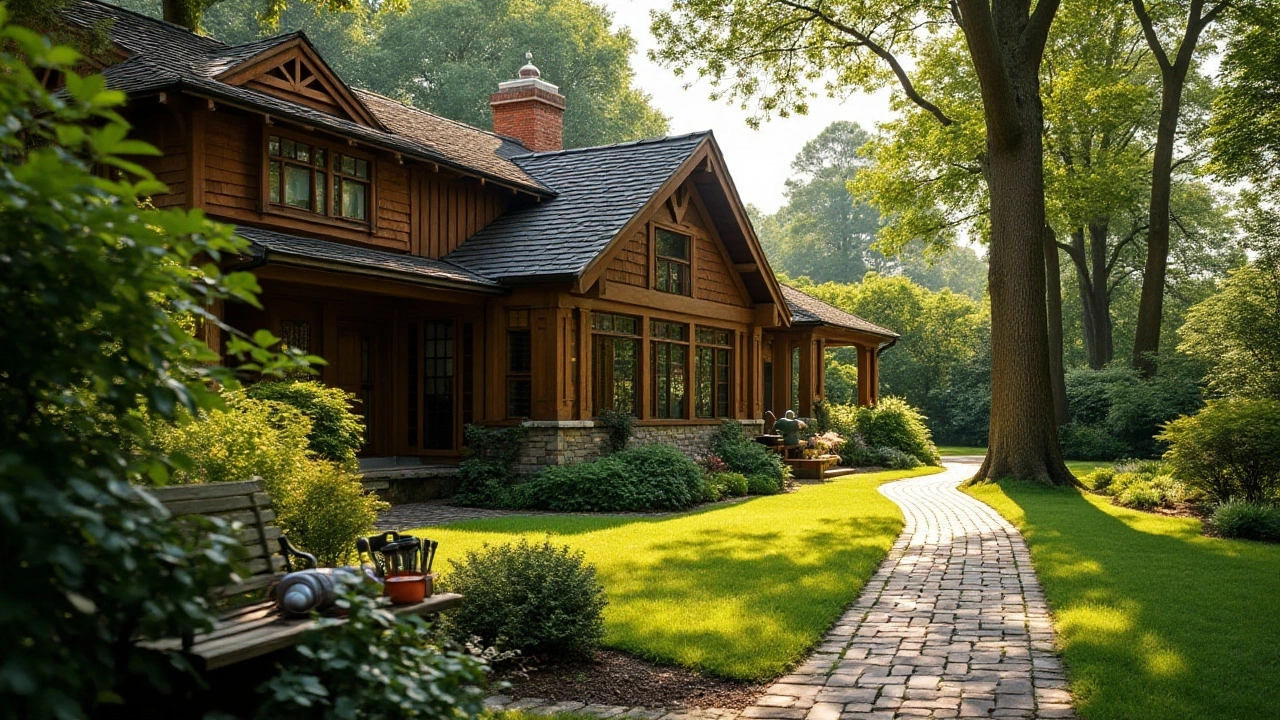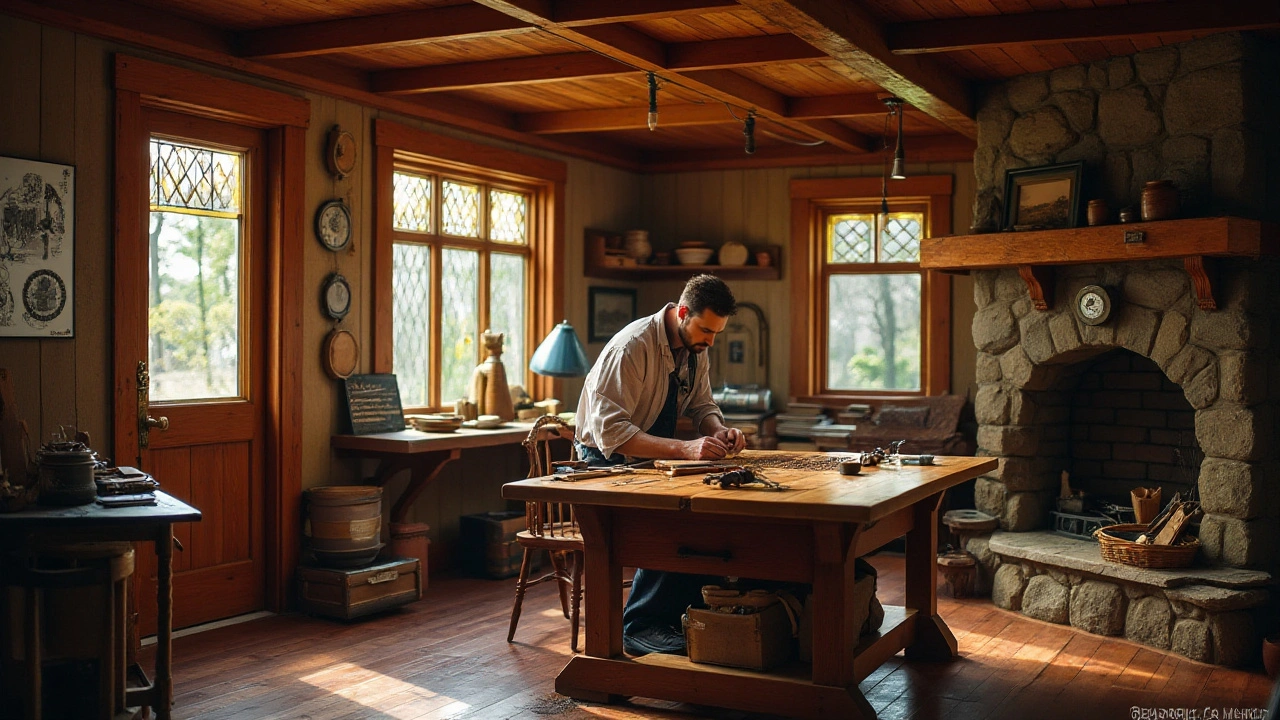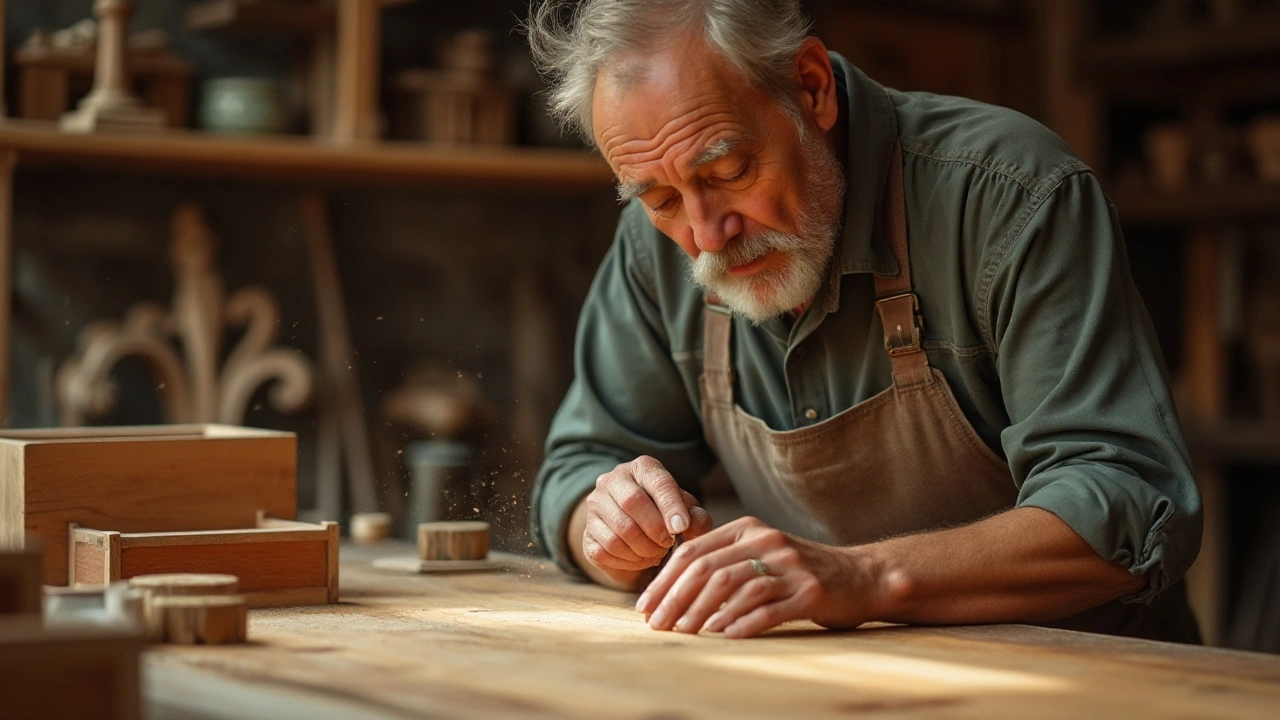Exploring the American Craftsman Style: Defining Elements and Legacy
 Oct, 5 2024
Oct, 5 2024
At the turn of the 20th century, a new architectural movement began to take hold in the United States, leaving a lasting impact on both design and culture. This was the American Craftsman style, an evolution that focused on simplicity, handiwork, and natural materials. It embodied an ideology – a return to skill and craftsmanship in the face of industrialization.
Recognizable by its emphasis on handcrafted work, the Craftsman style celebrated the skill of the maker, showcasing timber, stone, and iron in ways that highlighted their natural beauty. This movement arose partly as a reaction to the ornate and mass-produced decor of the Victorian era, turning instead towards a philosophy where form follows function.
Today, the beloved Craftsman style continues to shape expectations of modern architecture and interior design. Many homeowners still seek to incorporate its characteristic elements into their dwellings, whether through large architectural features or small decor touches. These nods to the past continue to resonate, proving that excellence in craftsmanship never goes out of style.
- Origins of American Craftsman
- Key Design Features
- Influence on Modern Architecture
- Incorporating Craftsman Style in Today's Homes
Origins of American Craftsman
The American Craftsman movement emerged in the late 19th century, as a beacon of rebellion against the rapid industrialization and mechanization that marked the era. At its core, the movement was inspired by the British Arts and Crafts movement led by figures like William Morris, who championed the importance of craftsmanship and the beauty of handmade objects. As America transitioned from agrarian roots to an industrial powerhouse, there was a palpable yearning for a return to simpler times—an era where artisans and their crafts were celebrated. The Craftsman style took hold in California and quickly spread to other parts of the country, driven by a desire for authenticity in both architecture and daily life.
The Craftsman bungalow, a staple of this style, became an architectural symbol of this return to organic, honest craftsmanship. These homes were often modest, single-story structures with open floor plans, emphasizing functionality alongside beauty. The aesthetics were not just visual but experiential, designed to blend seamlessly with their natural surroundings. This was an era where the philosophy espoused by the Craftsman style resonated deeply with the American psyche—a belief that beauty comes from truth to materials. A commitment to integrity in workmanship was paramount; homes were built to be lived in, not merely passed through.
An influential figure in promoting this movement was Gustav Stickley, a furniture maker and the founder of "The Craftsman" magazine. Stickley dedicated his publication to promoting the values and aesthetics of the style, which he described as "a dwelling of perfect symmetry and simplicity... adorned only with the marks of honesty." Not only did the magazine serve as a platform for architectural ideas, but it also provided practical advice on home building and decorating. This helped to democratize the Craftsman ideals, making them accessible to a wider audience of Americans eager to incorporate this new ethos into their lives.
While economic and social factors certainly played a role in its spread, the success of the Craftsman movement was also deeply tied to cultural shifts. During a time of significant societal change, where rapid urbanization often left individuals feeling disconnected from their physical environments, this style offered a grounded alternative. The love for handcrafted details, built-in furniture, and visible joinery was not simply about aesthetic choices; they were a declaration of individuality and artisanal skill. This architectural style echoed the aspirations of a changing America—one that still valued the craftsmanship amid the march towards modernity.

Key Design Features
American Craftsman style came to life with a distinctive set of features that celebrated the artistry and integrity of craftsmen of the era. At its core, this architectural style embraced a return to simplicity and functional beauty, moving away from the opulent and flashy designs of the previous century. Houses built in the American Craftsman style were often one or one-and-a-half stories tall, maintaining a natural and unpretentious relationship with the surrounding environment. Front porches with thick, square or round columns were a staple, inviting leisure and neighborly interaction—values cherished by those adopting this style.
The roofs, typically low-pitched and gabled, featured wide eaves adorned with exposed rafters, a modest acknowledgment of the structural elements behind the roofing. These honest, unornamented designs resonated with the idea that beauty should derive from the talent of the craftsman and not from unnecessary embellishments. The open floor plan inside allowed for flexibility and enabled a living experience centered around togetherness, reflecting an informal lifestyle. Wood was a preferred material, often left in its natural state or stained to showcase its inherent grain. This kind of workmanship invited a tactile relationship with the spaces, reminding inhabitants of the artisanal effort that went into each home.
Windows were also an important aspect of this style, typically arranged in sets of three or four, with the upper sashes often detailed with small, delicate panes, known to accentuate the fleeting sunlight and offer varied views of the outside world. Built-in furniture pieces, like benches, bookshelves, and even dining nooks, provided authentic charm and maximized limited space. The integration of such elements highlighted the skill of the craftsmen, whose works were considered a labor of love. Fireplaces served as the heart of the home, often constructed from natural stone, always adding a warm, rustic appeal.
"The Craftsman Style, at its best, is architecture revealing the character and personality of the materials." - Gustav Stickley, a key proponent of the Craftsman movement.
Color palettes in these homes drew from nature: earthy greens, browns, and tans were frequently used, creating a harmony with the landscape. This thoughtful coloration paid tribute to the movement's roots in nature's abundance. Occasionally, accent colors like cobalt blue or deep maroon would appear, subtly breaking the otherwise neutral hues without overwhelming the space. The harmony between indoor and outdoor elements symbolized a respect for natural surroundings, emphasizing simplicity and traditional craftsmanship as the highest form of art.
For those enamored with craftsmanship and natural materials, the Craftsman style provides a timeless design, illustrating enduring principles that continue to inspire architects and homeowners alike. From bungalows to grand homes, these key design elements have transcended time, welcoming future generations to appreciate the understated beauty and artistry of this culturally significant architectural style.

Influence on Modern Architecture
The impact of the American Craftsman style on modern architecture is both profound and widespread, echoing in the homes and interiors of today. As we step into a world with ever-evolving design trends, the principles established by Craftsman—simplicity, functionality, and the celebration of natural materials—continue to resonate deeply. Unlike any transient trend, the Craftsman ethos runs parallel with current values surrounding sustainable living and environmental mindfulness, creating a seamless bridge from past to present.
Architects and designers have found ways to incorporate Craftsman principles into contemporary designs, ensuring that its heart remains intact while adapting to modern needs. This often translates into open floor plans, abundant natural light, and natural materials like wood and stone, which have become staples in today’s home design. Distinguishing features such as visible beams and built-in furniture offer a nod to the Craftsman tradition, providing both practical and aesthetic benefits.
"The timeless appeal of Craftsman architecture lies in its simplicity and honesty," says renowned architect Sarah Susanka, who has been known for integrating these principles into her work.
The resurgence in popularity of bungalow styles and use of handcrafted details showcases how the Craftsman style has become intertwined with modern sensibilities. The push towards artisanal work, appreciation for handcrafted elements, and a focus on quality materials all echo the original Craftsman ideals, yet are adapted to meet the energy-efficient requirements of the 21st century. Homeowners now seek to include eco-friendly solutions, such as solar panels and energy-efficient windows, without sacrificing the distinctive coziness that Craftsman homes provide. Below is a glance at how Craftsman elements are utilized in today’s architecture:
- Exposed wood beams in living spaces
- Built-in shelving and seating using natural materials
- Stone or brick fireplaces as a focal point
Hence, while innovations continue to shape the way we live, the influence of the American Craftsman style can be seen in the care architects take in creating spaces that feel personal and harmonious with their surroundings. The marriage of traditional craftsmanship with modern aesthetics allows this magnificent style to thrive, nurturing a profound appreciation for structures that stand the test of time, embodying both beauty and function. As a result, the Craftsman style remains a beloved choice for many, living on to inspire future generations of design and architecture.

Incorporating Craftsman Style in Today's Homes
Bringing the charm of American Craftsman style into modern homes offers not just aesthetic appeal, but also a connection to a rich tradition of skilled workmanship. One of the key elements of this style is its focus on using natural materials, like wood and stone, that create a warm and inviting atmosphere. Homeowners today can make use of exposed wooden beams to enhance ceilings or opt for natural stone in fireplaces and accent walls. These elements don't just look good; they also bring a tactile appeal that adds depth and texture to any room. The authenticity of these materials provides a counterbalance to the man-made, synthetic components often found in contemporary design.
Spaces inspired by the Craftsman style often prioritize functionality without sacrificing beauty. Built-in cabinetry and seating areas are prime examples of this philosophy. Today's designers take cues from Craftsman's integrated approach by incorporating custom shelving units and window seats that offer both utility and style. These features can be tailored to fit individual needs, maximizing the use of available space while showcasing the artistry of bespoke craftsmanship. A well-placed built-in bench under a window, for instance, can transform a simple corner into a cozy reading nook, demonstrating how beauty can seamlessly meet functionality.
Lighting plays a significant role in achieving the Craftsman look. Fixtures traditionally feature clean lines and the use of metals and glass with a handcrafted feel, which works well with various design themes. In today's settings, one might choose lighting with iron frames or stained glass pendants that echo the style's roots. "The primary aim is to blend old-world charm with modern efficiency," says a featured designer in Architectural Digest. These elements not only illuminate a space but also add a dash of historical allure, creating an ambiance that is both timeless and contemporary.
Integrating Craftsman-style furnishings can enhance the aesthetic of any home. Furniture with simple lines and a robust build exemplifies this enduring style. In addition to antiques, many furniture companies today produce modern pieces inspired by the Craftsman movement, incorporating features such as visible joinery and minimalistic design. Consider adding solid oak or cherry wood furniture to living or dining areas to achieve this effect, as these materials offer both durability and timeless charm.
Another vital aspect is color schemes, which typically revolve around earthy tones that reflect the nature-infused inspiration of the Craftsman era. Shades of green, brown, and gold can be used on walls and furnishings to evoke a sense of tranquility and balance. Accent these with more vibrant splashes of red or blue through accessories like pillows, rugs, or art pieces. This strategic use of color not only reflects the organic origins of this design style but also promotes an atmosphere of cozy elegance.
Adopting the Craftsman style for modern homes requires an understanding of its foundational principles, yet offers ample opportunity for personalization. By combining traditional elements with modern conveniences, one can create spaces that honor the past and accommodate the present. This approach not only enhances visual appeal but also imbues spaces with a sense of history and timeless charm—factors that contribute to creating a home that feels genuinely alive and inviting.